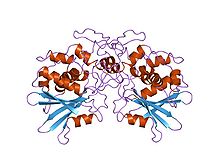| Ribosome-inactivating protein | |||||||||||
|---|---|---|---|---|---|---|---|---|---|---|---|
 Structure of pokeweed antiviral protein.[1] | |||||||||||
| Identifiers | |||||||||||
| Symbol | RIP | ||||||||||
| Pfam | PF00161 | ||||||||||
| InterPro | IPR001574 | ||||||||||
| PROSITE | PDOC00248 | ||||||||||
| SCOP2 | 1paf / SCOPe / SUPFAM | ||||||||||
| |||||||||||
A ribosome-inactivating protein (RIP) is a protein synthesis inhibitor that acts at the eukaryotic ribosome.[2] This protein family describes a large family of such proteins that work by acting as rRNA N-glycosylase (EC 3.2.2.22). They inactivate 60S ribosomal subunits by an N-glycosidic cleavage, which releases a specific adenine base from the sugar-phosphate backbone of 28S rRNA.[3][4][5] RIPs exist in bacteria and plants.[6]
Members of the family include shiga toxins, and type I (e.g. trichosanthin and luffin) and type II (e.g. ricin, agglutinin, and abrin) ribosome inactivating proteins (RIPs). All these toxins are structurally related. RIPs have been of considerable interest because of their potential use, conjugated with monoclonal antibodies, as immunotoxins to treat cancers. Further, trichosanthin has been shown to have potent activity against HIV-1-infected T cells and macrophages.[7] Elucidation of the structure-function relationships of RIPs has therefore become a major research effort. It is now known that RIPs are structurally related. A conserved glutamic residue has been implicated in the catalytic mechanism;[8] this lies near a conserved arginine residue, which also plays a role in catalysis.[9]
Only a minority of RIPs are toxic to humans when consumed, and proteins of this family are found in the vast majority of plants used for human consumption, such as Rice, Maize and Barley. In plants, they are thought to defend against pathogens and insects.[10]
- ^ Monzingo AF, Collins EJ, Ernst SR, Irvin JD, Robertus JD (October 1993). "The 2.5 A structure of pokeweed antiviral protein". Journal of Molecular Biology. 233 (4): 705–15. doi:10.1006/jmbi.1993.1547. PMID 8411176.
- ^ Ribosome+Inactivating+Proteins at the U.S. National Library of Medicine Medical Subject Headings (MeSH)
- ^ Endo Y, Tsurugi K, Yutsudo T, Takeda Y, Ogasawara T, Igarashi K (January 1988). "Site of action of a Vero toxin (VT2) from Escherichia coli O157:H7 and of Shiga toxin on eukaryotic ribosomes. RNA N-glycosidase activity of the toxins". European Journal of Biochemistry. 171 (1–2): 45–50. doi:10.1111/j.1432-1033.1988.tb13756.x. PMID 3276522.
- ^ May MJ, Hartley MR, Roberts LM, Krieg PA, Osborn RW, Lord JM (January 1989). "Ribosome inactivation by ricin A chain: a sensitive method to assess the activity of wild-type and mutant polypeptides". The EMBO Journal. 8 (1): 301–8. doi:10.1002/j.1460-2075.1989.tb03377.x. PMC 400803. PMID 2714255.
- ^ Funatsu G, Islam MR, Minami Y, Sung-Sil K, Kimura M (1991). "Conserved amino acid residues in ribosome-inactivating proteins from plants". Biochimie. 73 (7–8): 1157–61. doi:10.1016/0300-9084(91)90160-3. PMID 1742358.
- ^ Mak AN, Wong YT, An YJ, Cha SS, Sze KH, Au SW, et al. (2007). "Structure-function study of maize ribosome-inactivating protein: implications for the internal inactivation region and the sole glutamate in the active site". Nucleic Acids Research. 35 (18): 6259–67. doi:10.1093/nar/gkm687. PMC 2094058. PMID 17855394.
- ^ Zhou K, Fu Z, Chen M, Lin Y, Pan K (May 1994). "Structure of trichosanthin at 1.88 A resolution". Proteins. 19 (1): 4–13. doi:10.1002/prot.340190103. PMID 8066085. S2CID 21524411.
- ^ Hovde CJ, Calderwood SB, Mekalanos JJ, Collier RJ (April 1988). "Evidence that glutamic acid 167 is an active-site residue of Shiga-like toxin I". Proceedings of the National Academy of Sciences of the United States of America. 85 (8): 2568–72. Bibcode:1988PNAS...85.2568H. doi:10.1073/pnas.85.8.2568. PMC 280038. PMID 3357883.
- ^ Monzingo AF, Collins EJ, Ernst SR, Irvin JD, Robertus JD (October 1993). "The 2.5 A structure of pokeweed antiviral protein". Journal of Molecular Biology. 233 (4): 705–15. doi:10.1006/jmbi.1993.1547. PMID 8411176.
- ^ Zhu, Feng; Zhou, Yang-Kai; Ji, Zhao-Lin; Chen, Xiao-Ren (9 February 2018). "The Plant Ribosome-Inactivating Proteins Play Important Roles in Defense against Pathogens and Insect Pest Attacks". Frontiers in Plant Science. 9: 146. doi:10.3389/fpls.2018.00146. PMC 5811460. PMID 29479367.
© MMXXIII Rich X Search. We shall prevail. All rights reserved. Rich X Search
